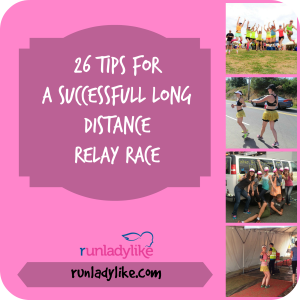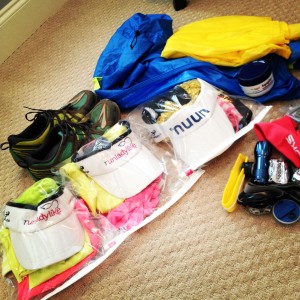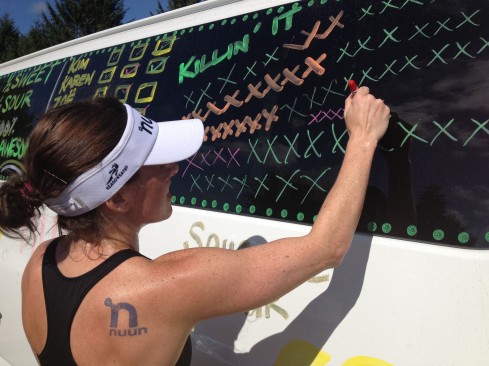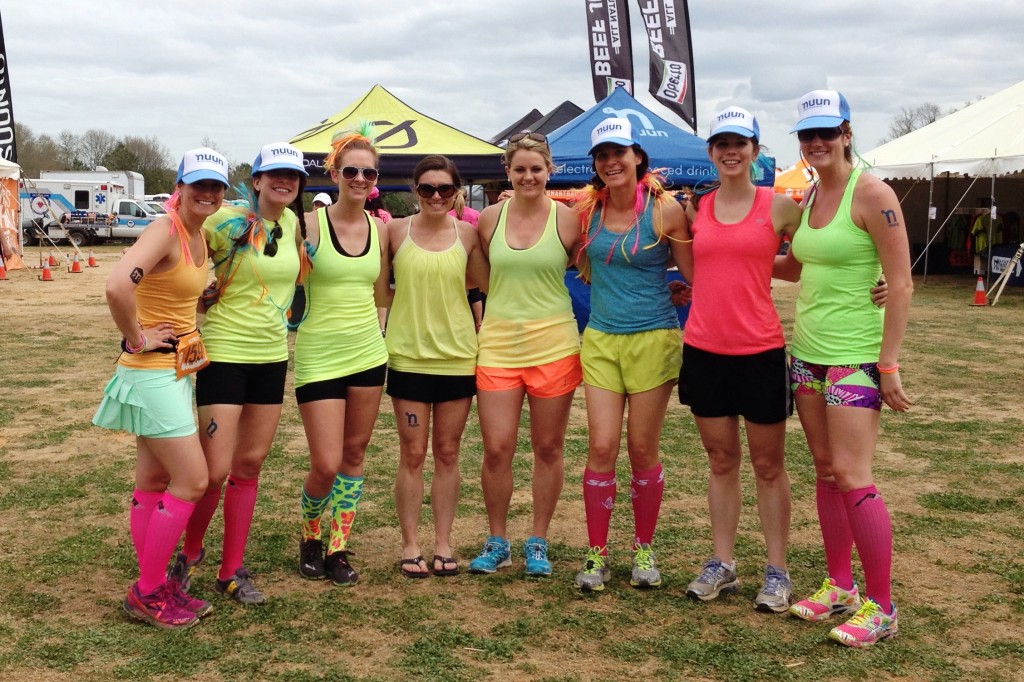26 Tips for a Long Distance Relay Race
At this time a year ago, I’d never participated in a long distance overnight relay race. I furiously searched Google for relay race tips and advice – what to bring, what to eat, how to be comfortable crammed in a van for 24+ hours. I talked to friends who had done a relay in the past. And since that time, I’ve run 2 relay races: the legendary Hood to Coast Relay last August (the world’s largest relay and one of the first of its kind) that covers 200 miles across Oregon and a Ragnar Trail Relay last month that was 130 miles on trails in Atlanta.
An estimated 200,000 runners participated in a relay race in 2012 (source). As relay races continue to grow, more and more runners will be gathering groups of their friends to take turns collectively running hundreds of miles together … because who doesn’t love functioning on little sleep, not taking showers and running on sore legs, right? (Trust me, it’s great!) For anyone who has never run an overnight relay like this, the course is split into legs (typically between 24 to 36). Each team can have between 4 and 12 runners, depending on the race. Each runner takes turns running their assigned legs (typically 3 for a team of 7 to 12 or 6 for teams of 4 to 6 runners doing an ultra relay).
If you’re thinking about doing your first relay race or you’re planning your next one, here are 26 tips for a long distance relay race and a successful experience. The tips below focus on traditional relays where a van is required to go from exchange point to exchange point, although some tips also apply to trail relays and others where there is a central headquarter location and no vans/traveling are required.

1. Eat wisely. You know that saying “You are what you eat?” That has never been truer than at an overnight relay race. Runners who don’t have stomach issues often experience them due to an unusual eating and sleeping schedule (and being surrounded by lots of food you likely don’t eat before, during or after running). Have a plan for what you’re going to eat and try to stick to it. Think about how you prepare for traditional road races, and try to follow that similar pattern before each of your legs. For instance, I would recommend eating a good mix of carbs and protein about 2 hours before running and a few Clif Shot Bloks or other similar race fuel 30 minutes before your leg. At Hood to Coast last year, I ended up eating Red Vines and pretzels for most of my meals (don’t ask me why!), which sent me into a diarrhea coma for hours between my first and second leg (#unladylike). Not fun.
2. Carry your phone with you on the run. There is a lot of navigating that has to happen at every relay. Not only does your van need to get from one exchange to the next, but sometimes your team encounters traffic or gets lost. Be sure to carry a phone with you in case you or your teammates get lost so you can find them. Also, since you will likely run at least once during the middle of the night alone, it’s important to be able to communicate if you get hurt or lost.
3. Have a driver (who isn’t running). Most relay races cover more than 100 to 200 miles and travel across a state or region. Driving from exchange to exchange and knowing where you’re going is critical to a successful event. After running and being tired, the last thing you’re going to want to do as a runner is get behind the wheel of a 15-passenger van (and yes, you need a 15-passenger van to comfortably fit everyone’s stuff and have plenty of space to spread out … I recommend no more than 6 team members and your driver per van). Ask a friend, family member, spouse or fellow running friend to be your driver. Bribe them with something cool for staying up all night with you as your running chauffeur.
4. Have a cell phone charging plan. At an event that lasts up to 30 hours, your smart phone is sure to die. Be sure to have a plan for how you will keep your phones charged. At Hood to Coast, we took turns plugging our phones into the van’s USB outlet so they were all charged for our runs. At Ragnar Trail, there was a charging station, but it wasn’t active at night so most of our phones died. Consider bringing a back-up camera in case that happens, but make plans to bring some type of charging device so you don’t find yourself running without communication.
5. Bring a foam roller or stick. With little time to stretch after each run and jumping right back into a van, your legs are going to get sore and tight. Bring a foam roller, stick or your other favorite running recovery gear to stay loose and work out your muscles.
6. Run with a wet wipe. Just trust me on this. If you read tip #1, then you understand what might be possible while running. Let’s just say several of my team members in the past have had to make a pit stop in the woods during their legs. Better to be prepared than sorry.
7. Sleep! When you’re crammed in a van and lots is happening around you, it can be hard to sleep … or want to sleep. But try! Even a few hours will help you feel refreshed and get you through your last leg. At some relays, you’ll have time to stop off in a field or parking lot to rest. Take advantage of this time to get some shut-eye. At my recent trail relay, I laid down in a tent in between legs (there was a base camp, no vans) and closed my eyes whether I felt tired or not. I probably got about 3 hours of total sleep, but I felt much better than I would have without it.
8. Bring a pillow and blanket. How can you be expected to sleep without these? Invest in a travel pillow (I got one with a mini pillow case from Bed Bath & Beyond for $20). This and a blanket will be a lifesaver for you while you’re jammed in a van seat and are feeling tired (and cold). These will do wonders for your comfort and ability to sleep.
9. Get creative running with music. There are 3 words I dread hearing: “NO MUSIC ALLOWED.” This is the case with most relays. Music really helps me stay motivated, especially when I’m alone or running in the dark. I carried my iPhone in an HB Tunes case that attached to my hand and played the music through the phone’s speakers (no ear buds). It was great. Others use a vest and put their phone in their pocket while it is playing. At Ragnar, music is “discouraged” but not “prohibited,” so I ran with one ear bud in and all I can say is it got me through the tough parts and made the trail runs more fun and exciting. If you live and die by running with music like me, you can do it, you just have to be a little creative.
10. Ziploc freezer bags are a must! When I was a little kid and my family would go on vacation, my mom would pack all my outfits in Ziploc bags to make sure we didn’t forget anything: shirt, socks, shorts, underwear, hair bows … the whole thing. Well, running relays is the same way. The best advice of anything I can tell you is to pack each of your outfits for all your legs in a large Ziploc bag (freezer size). Include your socks, visor/hat and anything you might be using during that leg. Then, when you’re done, put the wet, sweaty, stinky clothes back in the bag and zip it up. This will prevent lots of stinkiness from invading your van or campsite. When you get home and open them all back up to wash them though, you might want to plug your nose.

11. Master the baby wipe shower. In a relay race, you will run 3 to 6 times and not shower for 30 hours. Mmm. Refreshing. The best way to stay clean and dry is to wipe yourself down with baby wipes after each leg. Often times, you may have to do this in a porta potty while balancing your change of clothes tucked under your chin or in your teeth. Other times, you might be lucky enough to find a public restroom where you can change and clean up. Baby wipes are a must-have during any relay race. Ragnar Trail events offer showers for $10, but I think baby wipes are more realistic since you’ll have to turn around and run again in 5 hours.
12. Don’t be afraid of kills. The term “kills” is a common word used in relay races to represent how many people you pass during each leg. It is very common for relay teams to mark how many kills – or people each team member passed – on the side of the van with window paint. When I first heard about this, I thought it was a mean idea. I’m someone who likes to celebrate everyone out there running and not focus on people I pass, but I soon found out this is all in good fun and is not really offensive. I found that focusing on people in front of me and trying to pass them got me through tough legs and gave me something to work toward.

13. Embrace soreness. By your third (or last) leg of a relay race, you are going to be sore. I was “half marathon/marathon sore” after Hood to Coast, and my ankles were super sore after Ragnar Trail. It may even be hard getting in and out of the van toward the end of the race. Embrace it. Know you are going to be sore so you can mentally keep pushing through. My last legs for both my relays have been some of my fastest, even when my body was tired.
14. Bring a first aid kit. This should go without saying. Enough said.
15. Wear unifying team clothes. Although definitely not a requirement, it’s fun to rally your team around a theme. For Hood to Coast, our team wore yellow and pink. At Ragnar Trail, we all wore neon/florescent colors. It not only helps you stand out as a unified group, but it also makes spotting your team members coming into the exchange area easier.

16. Find ways to cheer for runners on the course. Running is so often an individual sport. Even though we may train with a group and have a tremendous support system, at the end of the day, it’s our own inner strength and drive that must kick in. That’s one of the reasons relay races are so fun … they truly are a team effort. And it’s awesome to have your team out on your route cheering you on (and taking pictures of you). Whether you see your van stopped along the way or you have your whole team waiting for you at the exchange area, show each runner lots of support and encouragement.
17. Know what your routes are like before you run. Some of your running legs may have coarse gravel or lots of dust. Some may have steep hills while others are fast down hills. Know what to expect so you can be prepared to wear the right shoes or carry the right gear with you (e.g. if you’re running in a dusty area, cover your face with a bandana, etc.).
18. Bring something comfy to wear between legs. Have 1 to 2 outfits you can change into in between your running legs. Choose something warm and comfy, such as pajama pants and flip flops. You may also want to bring compression socks to help your legs recover quicker. The last thing you want to do is sit around in damp running clothes for hours at a time.
19. Bring a towel or yoga mat. When your team has a chance to get out of the van and stop for a bit while other runners are on the course, having a yoga mat or towel to do some stretching on is a lifesaver. I laid a towel down in a field during Hood to Coast and foam rolled and stretched. I did the same with a yoga mat at Ragnar Trail.
20. Paint/decorate your van. If you’re doing a relay that requires you to travel from exchange to exchange as a team, decorate the outside of your van with your team name, colors, Twitter handle/hashtag, etc. It’s fun to get together as a group using window paint that’s safe for vehicle windows. If you’re renting your van, know that you will need to wash it off before returning it to the rental location and be sure to test the paint in a small area to ensure it washes off completely before decorating.
21. Have a great playlist. As the hours pass by and your team begins to get tired, keeping up the morale and energy is key. Have a great playlist for your van to keep spirits high. Consider creating a Spotify playlist that the entire team can contribute to leading up to the race. Tell funny stories. Play games. Whatever it takes to keep the positive energy up!
22. Have at least one person on your team who has done a relay before. While certainly not mandatory, this is SUCH a helpful thing to have when you are doing your first relay with others who have never done one before either. Having someone who knows what to expect helps everyone on the team.
23. Be prepared to run at night. At least one of your legs is likely to be in the dark. Be sure that each person on the team has a good quality head lamp, ideally with 70 lumens or more. You will also need reflective vests and blinking lights for your front and back. Knuckle lights are also really helpful. They slip onto your hands and shine down on the ground as you run. With a good head lamp, you shouldn’t have any trouble running in the dark, even on trails.
24. Travel smart. If you’re traveling a far way to a relay race, give yourself some time before and after the race. When I ran Hood to Coast last year, I had a 4-hour plane ride and a 3-hour time change. It was nice to spend 2 nights in Seattle before starting the race. Likewise, you are going to be tired the day after the race, so you may want to take the day off work or take your time traveling back so you can catch up on sleep and relax your tired legs.
25. Bring 2 pairs of shoes. It’s nice to have 2 pairs of shoes in case any of your legs are in the rain, mud, etc. That will give them some time to dry while preventing you from having to run in wet shoes. If you are doing a Ragnar Trail race or other trail relay race, you will definitely want to run in trail-specific shoes.
26. Stay hydrated. I can’t emphasize this enough. With 6 to 8 people on a team, you will need a lot of water and sports drink. Consider having a big cooler/jug of water with a spout (like those big orange Gatorade jugs) that everyone can fill water up with. If you are racing somewhere where there are dry conditions or high altitude, you will want to be even more mindful of this.
Running a relay race is a great way to bond with other runners and friends and to see a state or new part of the country. Remember to enjoy the miles, don’t worry about time/pace and get ready for an awesome adventure.
Want more relay race tips? Check out these posts you might have missed:
My Relay Packing List
10 Truths about Running I learned from Hood to Coast
Hood to Coast Race Recap
Ragnar Trail Race Recap
More Wayst to Connect with rUnladylike:
Twitter: @rUnladylike
Facebook: https://www.facebook.com/runladylike
Instagram: http://instagram.com/runladylike/
Daily Mile: http://www.dailymile.com/people/jesica
Pinterest: http://www.pinterest.com/JesicaD/
Follow rUnladylike with Bloglovin
Have you run a relay race? If so, what did you think? Which has been your favorite? What other relay race tips would you add to this list?



Comments
These are great tips! I’ll be using/sharing some of these when I run Reach the Beach as part of a ultra relay team in the fall…btw any chance you want to join us and run 50 miles in 24 hours? 🙂
LOL Sarah! I’m not sure I could survive a 50-miler, but you never know… 🙂
This is such a great list! I can’t even think of anything to add. I wished you’d written it before my Ragnar. A couple of us brought Action Wipes instead of baby wipes, which I preferred because they are much larger and thicker. So smart to carry a wipe with you. I didn’t, but I sure could have used it on my second leg! We could also have used a great playlist but we listened to the radio instead which meant that we heard the same 10 songs over and over again. Now the song Happy will forever remind me of Ragnar and my great van mates.
Great list! I can’t believe that you came up with 26 things! I think you pretty much have the covered! 😉
This is great! I am running my first reach the beach in Sept. On an ultra team this is huge help! Thanks!
That is awesome Kate! I’ve heard that is a great race! Glad these tips will help. Good luck! xo
So timely – I’m doing my first Ragnar this weekend (Cape Cod)! Thanks for putting this together 🙂
Exciting Beth! Good luck this weekend and have a blast! Can’t wait to hear what you think! xo
Love love love this! A relay race is on my bucket list…I will definitely remember this!
I really love this. I hope to run a relay sometime soon… They just have to bring one to my area first!
I absolutely LOVE this!! 🙂 And I can imagine you recounting the whole relay as you put this together…fun memories!! I love reading your blog and want to pass on the love…so I’ve nominated you for a Liebster Award on my blog Daydreams & Shoestrings: http://daydreamsandshoestrings.com/2014/05/07/liebster-award-round-2/
Thank you so much Jen! I really appreciate the love and the nomination. I love reading about all your fun facts. Thank you again! xoxo
Such a great list! I’m sure I’ll be referring back to it prior to running Hood to Coast with Nuun this year. Thanks for the post.
[…] liked this one and a very detailed 2012 experience […]
[…] 26 Relay Race Tips for a Long Distance Relay Race – Run Lady Like […]